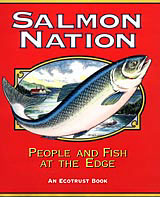salmon
-
Salmon fishing season in California and Oregon may be canceled
So few salmon are swimming in California and Oregon that salmon fishing season is likely to be canceled completely unless an emergency exemption is granted, according to the federal Pacific Fishery Management Council. The states’ salmon season, which traditionally runs from April to mid-November, has never been entirely canceled before. Even with a complete closure, […]
-
Oregon coast coho salmon re-listed as threatened
Coho salmon off the Oregon coast have been re-listed as threatened under the Endangered Species Act. Yesterday’s move was compelled by a court-ordered deadline mandating that the NOAA Fisheries Service reconsider its 2006 decision to delist the coho because it wasn’t based on the best available science. The Oregon coastal coho stock has been the […]
-
Bar codes for salmon and shark-free moisturizer
Scientists found that up to 6,000 metric tons of sunscreen washes off swimmers annually, and that the sunscreen contains chemicals that lead to bleaching corals. They estimated that up to 10 percent of corals were threatened by sunscreen-related bleaching ...
... the Central Valley, Calif., chinook salmon run, which had historically been one of the West Coast's strongest, fell to record lows this year, prompting concerns about collapse ...
... researchers in North Carolina studied how to raise fish for consumption in tanks ...
... a seafood consumer center in Oregon prepped for a program that would attach bar codes to salmon, allowing consumers to learn who caught the fish, where it was caught, and how it traveled to market ...
-
California’s chinook salmon population near “unprecedented collapse”
The number of chinook salmon returning from the Pacific Ocean to California’s Sacramento River is near record lows and points to an “unprecedented collapse,” according to fisheries managers. In 2007, only about 90,000 adult chinook returned to the Sacramento River, down from about 277,000 in 2006 and a high of over 800,000 in 2002. Even […]
-
The damming question
It's been 50 years since Celilo Falls in Oregon was buried by the Dalles Dam to create 800 megawatts of power, but the memory of the great salmon runs lost live on through the tribes who migrated again this year to the spot to mourn the day. Orion Grassroots Network member group Save Our Wild Salmon opined eloquently in the Oregonian this week about the choices our society made for green power.
-
David James Duncan rows through a wheat field to save salmon — and we’ve got pictures
Photo: Frederic Ohlinger “The miracle meal after the Sermon on the Mount was both loaves and fishes,” says author and storyteller David James Duncan. “Not one or the other. Both.” It’s a sentiment that helps to explain why Duncan and a variety of compatriots were photographed in 13 colorful dories, rowing and casting lines — […]
-
Lice Age
Farmed salmon infect wild stocks with sea lice, study finds A new study of wild and farmed salmon in the Pacific Northwest reveals that farmed salmon breed parasitic sea lice that infect juvenile wild salmon swimming nearby and could affect stocks of other important commercial species. A Canadian research trio looked at some 5,500 young […]
-
Atlantic salmon are even worse off than their Pacific cousins
To catch an Atlantic salmon in the Machias River back in the 1940s — and we’re talking a legitimate salmon here, maybe 30 or 40 pounds — didn’t require a knack with rod and reel, nor even the wily patience of the angler. Mostly what you needed was decent aim with a rifle or pitchfork […]
-
Do you know where your salmon comes from?
Thirty percent of the world's salmon now come from hatcheries, but wild fish account for only another twenty to thirty percent. Almost all of those wild fish come from waters around Alaska and British Columbia, northern waters where runs are mostly intact. These are the waters from which we harvest volumes comparable to those native people caught for thousands of years, that is, in those places largely unmanaged. The biggest share of the world's salmon consumption, however -- now forty to fifty percent -- comes from farmed fish, salmon raised and fed artificially in net pens their entire lives.
